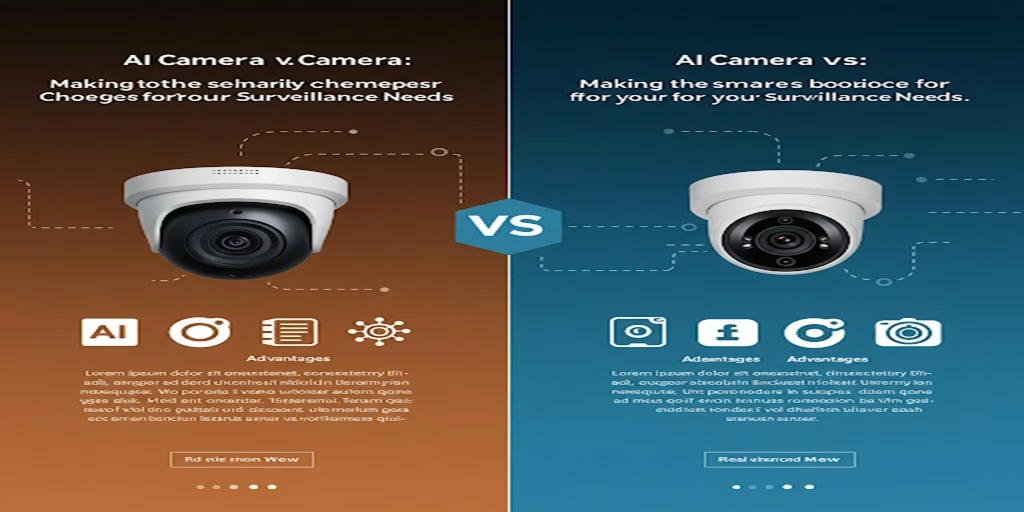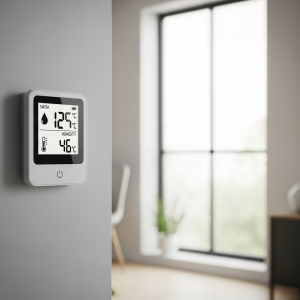AI Camera vs Security Camera:
How to Choose?
In an increasingly security-conscious world, the demand for effective surveillance solutions has surged. Both traditional security cameras and the newer, more sophisticated AI cameras offer means to monitor our homes, businesses, and public spaces. However, beneath the shared goal of capturing footage lies a significant divergence in technology, capabilities, and ultimately, the value they provide. Understanding these distinctions is crucial for making an informed decision that aligns with your specific security requirements and budget.
AI cameras VS security cameras:dissecting their functionalities, advantages, disadvantages, and the key factors to consider when choosing between them.
AI Camera VS Security Camera, How to Choose?
The Foundation: Traditional Security Camera
For decades, traditional security cameras have been the workhorse of surveillance. Their core function is straightforward: to capture video footage of a designated area. These cameras typically rely on basic components: a lens to focus light onto an image sensor, circuitry to process the image, and a recording mechanism, which could be a built-in storage device, a connected digital video recorder (DVR), or network video recorder (NVR).
Key Characteristics of Traditional Security Cameras:
- Basic Video Capture: Their primary function is to record visual information. The quality of this footage can vary significantly based on factors like resolution (e.g., 720p, 1080p, 4K), lens quality, and sensor size.
- Motion Detection (Rudimentary): Many traditional cameras feature motion detection, but this is often a simple pixel-based analysis. Any change in the image, such as a shadow moving or a leaf falling, can trigger an alert and recording. This often leads to a high number of false alarms.
- Manual Configuration: Setting up motion detection zones or adjusting sensitivity levels typically requires manual configuration through the camera’s interface or connected recording device.
- Reactive Security: Traditional cameras are largely reactive. They record events as they happen, and the onus is on the user to review the footage after an incident has occurred.
- Limited Analytics: These cameras generally lack sophisticated analytical capabilities. They cannot distinguish between a person and an animal, identify specific objects, or understand complex patterns of behavior.
- Local Storage Dependency: Footage is often stored locally on DVRs or NVRs, requiring physical access to retrieve recordings. Storage capacity can be a limitation, and the security of the recordings depends on the security of the recording device itself.
Lower Initial Cost: Generally, traditional security cameras have a lower upfront cost compared to their AI-powered counterparts.
Advantages of Traditional Security Cameras:
- Affordability: The lower initial investment makes them accessible for basic surveillance needs.
- Simplicity: Their straightforward functionality can be easier to understand and set up for some users.
- Established Technology: The technology is mature and widely understood, with a large pool of installers and support resources available.
Disadvantages of Traditional Security Cameras:
- High Rate of False Alarms: Simple motion detection leads to numerous irrelevant alerts, wasting time and attention.
- Time-Consuming Footage Review: Sifting through hours of footage to find a specific event can be tedious and inefficient.
- Limited Proactive Capabilities: They offer little in the way of preventing incidents or providing real-time insights.
- Scalability Challenges: Expanding a traditional system can involve significant hardware investment and complex wiring.
The Intelligent Leap: AI-Powered Cameras
AI cameras represent a paradigm shift in surveillance technology by integrating artificial intelligence algorithms directly into the camera hardware or associated software. This enables them to go beyond simply capturing video and perform intelligent analysis in real-time.
Key Characteristics of AI Cameras:
- Intelligent Video Analytics: The core strength of AI cameras lies in their ability to analyze video streams using sophisticated algorithms. This allows for features like:
- Object Detection: Identifying and classifying objects such as people, vehicles, animals, packages, and more.
- Facial Recognition: Recognizing known individuals based on stored facial data (raising significant privacy considerations).
- License Plate Recognition (LPR): Automatically capturing and identifying vehicle license plates.
- Anomaly Detection: Identifying unusual patterns of behavior or objects in a scene.
- Intrusion Detection: Defining virtual tripwires or zones and alerting when specific objects cross them.
- People Counting: Tracking the number of individuals entering or exiting an area.
- Heat Mapping: Visualizing areas with high concentrations of movement.
- Smart Alerts: By understanding the context of the scene, AI cameras can significantly reduce false alarms. They can be configured to alert only when specific objects (e.g., a person) enter a defined zone, ignoring pets or moving foliage.
- Proactive Security: AI-powered analytics enable more proactive security measures. For instance, an alert can be triggered if a person loiters in a restricted area for an extended period.
- Enhanced Monitoring and Search Capabilities: AI systems often tag events based on the detected objects or behaviors, making it much easier and faster to search through recorded footage. Instead of watching hours of video, you can search for specific instances of a “person” or a “vehicle.”
- Integration with Smart Systems: Many AI cameras can integrate with other smart home or security systems, allowing for automated responses based on detected events (e.g., turning on lights when a person is detected at the door).
- Cloud Connectivity and Advanced Features: AI cameras often leverage cloud processing and storage, enabling remote access, advanced analytics in the cloud, and over-the-air software updates that introduce new features and improvements.
- Higher Initial Cost: The advanced technology and processing power within AI cameras typically result in a higher upfront investment.
Advantages of AI Cameras:
- Significantly Reduced False Alarms: Intelligent analysis filters out irrelevant motion, leading to fewer and more meaningful alerts.
- Enhanced Efficiency in Footage Review: AI-powered tagging and search drastically reduce the time required to find specific events.
- Proactive Security and Real-Time Insights: The ability to detect and analyze events in real-time allows for more proactive security measures and valuable insights into activity patterns.
- Improved Accuracy and Reliability: AI algorithms can be more accurate and consistent in detecting and classifying events compared to simple motion detection.
- Scalability and Flexibility: Cloud-based AI systems often offer better scalability and flexibility, allowing for easier expansion and integration with other services.
- Potential for Automation: Integration with other smart systems can automate security responses and workflows.
Disadvantages of AI Cameras:
- Higher Initial Cost: The advanced technology comes with a premium price tag.
- Privacy Concerns: Features like facial recognition raise significant privacy concerns and require careful consideration of ethical and legal implications. Data security is also paramount.
- Dependence on Software and Updates: The performance and features of AI cameras rely heavily on their software and regular updates.
- Potential for Bias in Algorithms: AI algorithms are trained on data, and if that data is biased, it can lead to inaccurate or unfair results (e.g., less accurate facial recognition for certain demographics).
- Internet Connectivity Requirements: Many advanced features of AI cameras rely on a stable internet connection.
AI Camera VS Security Camera, How to Choose? Factors to Consider
Choosing between an AI camera and a traditional security camera depends heavily on your specific needs, budget, and tolerance for complexity. Here are some key factors to consider:
1. Security Requirements:
- Basic Surveillance: If your primary need is simply to record what’s happening for potential later review, and you are comfortable with the possibility of sifting through a lot of footage and dealing with false alarms, traditional cameras might suffice.
- Proactive Security and Real-Time Alerts: If you need to be alerted to specific events in real-time (e.g., a person entering your property after hours), and want to minimize false alarms, an AI camera with intelligent object detection is a better choice.
- Specific Identification Needs: If you require the ability to identify individuals (facial recognition) or vehicles (license plate recognition), AI cameras with these specific features are necessary. However, carefully consider the legal and ethical implications of such features.
- Anomaly Detection: If you need to identify unusual behavior or objects that deviate from the norm, AI cameras with anomaly detection capabilities are essential.
2. Budget:
- Upfront Cost: Traditional cameras generally have a lower initial purchase price.
- Long-Term Cost: Consider the long-term costs associated with storage (cloud subscriptions for AI cameras vs. hardware upgrades for traditional systems), potential false alarm responses, and the time spent reviewing footage. While the initial cost of AI cameras is higher, the time and effort saved through intelligent analysis can provide long-term value.
3. Complexity and Ease of Use:
- Setup and Configuration: Traditional cameras can be simpler to set up for basic recording. AI cameras often involve more software configuration and network integration.
- User Interface: The user interfaces for managing AI cameras and their features can be more complex but also offer more control and information.
- Maintenance: Both types of cameras require some level of maintenance, but AI cameras may involve software updates and cloud service management.
4. Privacy Considerations:
- Data Security: With AI cameras, especially those utilizing cloud services, data security is paramount. Ensure the vendor has robust security measures in place to protect your video data.
- Facial Recognition Ethics: If you are considering AI cameras with facial recognition, carefully weigh the ethical and legal implications and ensure compliance with relevant regulations. Transparency with those being monitored is crucial.
- Data Usage: Understand how the AI algorithms process and use your video data. Choose vendors with clear and transparent privacy policies.
5. Scalability and Integration:
- Future Expansion: If you anticipate expanding your surveillance system in the future, consider the scalability of the chosen technology. AI-based systems often offer better scalability through cloud infrastructure.
- Integration with Other Systems: If you want your security cameras to integrate with other smart home or security devices, check the compatibility of both traditional and AI camera systems.
6. Environmental Factors:
- Indoor vs. Outdoor Use: Ensure the chosen cameras are designed for the intended environment (weatherproof for outdoor use, appropriate viewing angles for indoor spaces).
- Lighting Conditions: Consider the low-light performance of the cameras. Some AI cameras have advanced night vision capabilities.
Scenarios and Recommendations:
- Basic Home Security (Budget-Conscious): For simple monitoring of entry points without advanced analytics, a set of high-quality traditional security cameras with reliable motion detection and local recording might suffice.
- Small Business Security (Preventing Theft and Intrusion): AI cameras with object detection, intrusion alerts, and cloud storage can provide more effective security by minimizing false alarms and enabling quick review of relevant events.
- Large Property or Complex Environment (Detailed Monitoring and Analysis): AI cameras with features like facial recognition (with careful consideration of privacy), license plate recognition, and anomaly detection can provide valuable insights and enhance security.
- Smart Home Integration: If you want your security cameras to work seamlessly with other smart home devices, choose AI cameras that offer robust integration options.
Conclusion: Investing in Smarter Security
The choice between an AI camera and a traditional security camera ultimately boils down to your specific needs and priorities. While traditional cameras offer a more budget-friendly entry point into surveillance, AI cameras provide a significant leap forward in terms of intelligence, accuracy, and proactive security capabilities.
As AI technology continues to evolve and become more accessible, we can expect AI cameras to become increasingly prevalent. By carefully considering the factors outlined in this guide, you can make an informed decision and invest in a surveillance solution that truly enhances your security and provides peace of mind in an increasingly complex world. Remember to weigh the benefits of advanced analytics against the potential costs and privacy implications to make the smart choice for your unique circumstances.





